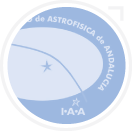Water cycle
Mars possesses an active hydrological cycle characterized by large spatial and seasonal variations of water vapor, ice clouds, and surface frost. Understanding this cycle is very important as it is thought to play a major role in the present-day Mars climate and photochemistry, but also because its variations in the past millions years has strongly influenced Mars recent geology (for example by the formation of sub-surface ice and clathrates), environment and habitability.
Mars water cycle processes have been studied by combining analysis of observations and climate model simulations. It is known that every summer large amounts of water vapor sublime from the permanently ice-covered surfaces of the Polar Regions. Water is then transported globally by winds and later condenses back at the poles to sublime again the following summer. In some places, specific processes induce the condensation of clouds, which are thin compared to the Earth, but which are known to play a key role in the transport of water and on the overall climate system through their radiative effect. In some locations, even outside the Polar Regions, water can condense onto the surface to form thin frost layers, which can last between a few hours (at night) up to several tens of days (during fall and winter). This frost reservoir is also of key importance in the water cycle and its interannual variability. Similarly, the role of the regolith as a seasonal reservoir for water is discussed as well, but presently remains the least constrained of the water cycle components.
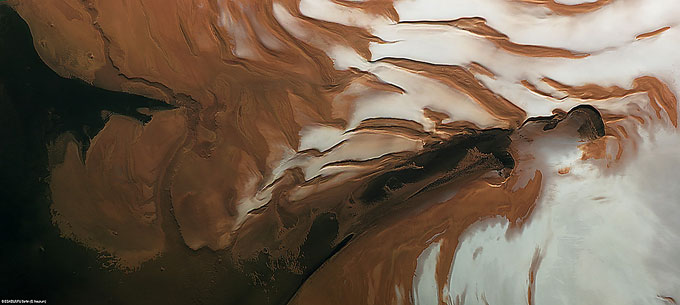
This image acquired by the Mars Express High-Resolution Stereo Camera in 2010 shows a part of the northern polar region of Mars at the northern hemisphere summer solstice. After warmer temperatures evaporated carbon dioxide ice, water ice remains on the surface. (Photo credit: ESA/DLR/FU Berlin)
Despite several major efforts to understand and simulate the water cycle, the most recent studies have shown that several aspects of the cycle remain enigmatic. It appears that one or more physical processes at work are not well understood nor is it taken into account in climate models. In particular, when the radiative effect of clouds is taken into account, recent studies have shown that the strong positive feedback between clouds, temperature and water condensation / sublimation tend to prevent models from properly reproducing the observations. The vertical distribution of water vapor and its diurnal cycle also remain poorly understood.
Understanding the cycle
The objective of this project is to gather all available observations on water vapor, frost and especially clouds that can lead to a better understanding of the Mars water cycle and cloud formation and in particular quantitatively characterize the process at work to improve the climate models. This includes the retrieval of new datasets from Mars Express observations (mapping of cloud optical depth and particle size over various local times and over several years using the near infrared and UV observations from SPICAM and OMEGA) and a comprehensive study of available data on water vapour and frost.
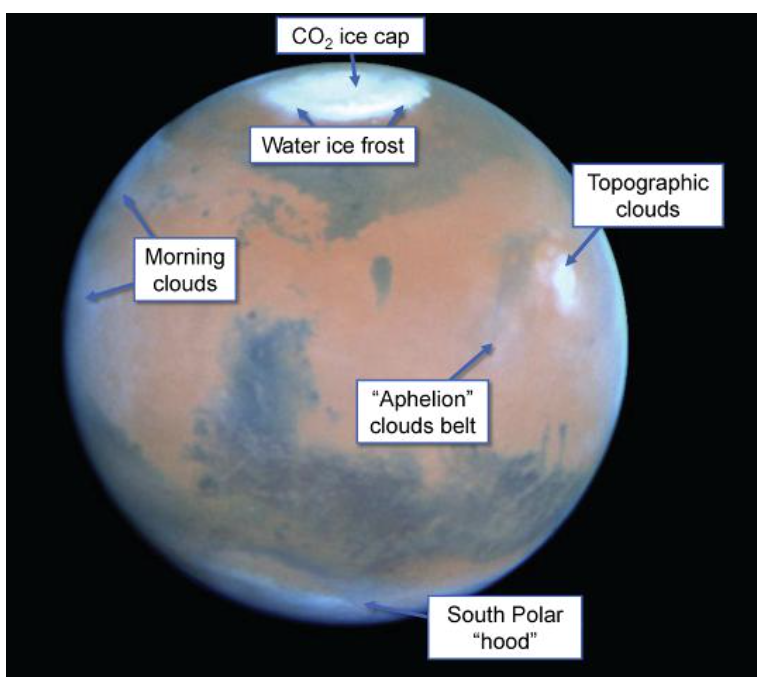
OMEGA y SPICAM
Regarding OMEGA data, we will apply an inverse method to the NIR spectral data to retrieve cloud particle size and opacity overall the entire OMEGA dataset. In practice a model of the cloud properties is fitted to the observed spectra (along with the dust signature and the aerosol-free surface spectra estimated from observations acquired at other seasons). The feasibility of this method has been demonstrated in Madeleine et al. (2012a) where further details are given. They were able to map and characterize clouds on a selection of OMEGA observations. However, they were limited by the need for aerosol free surface spectra overall the planet. Our global mapping project will be made possible by the new surface spectral map by UPWARDS. This unique dataset will provide a new constraint on Climate models, for the first time at various local times.
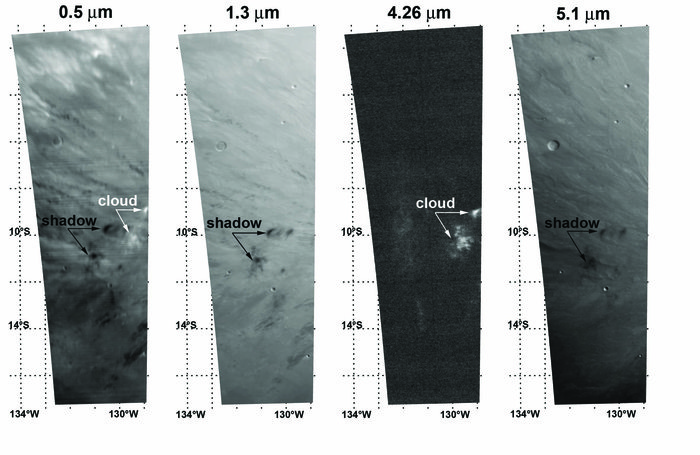
This image composite shows the carbon-dioxide-ice (CO2) cloud detected by OMEGA imaging spectrometer aboard ESA’s Mars Express on 12 June 2004, during spring in the northern hemisphere. At that time, Mars Express was flying at more than 2000 km over the surface of the planet. The cloud was situated at 80 km altitude. ESA/OMEGA team
For the SPICAM data, our main goal is to build an automatic tool to detect the presence of clouds using nadir observations in the UV spectral region, where they are much brighter than dust or the surface. The algorithm will be able to detect clouds above the dark regolith, but also above the brighter ice polar caps. It will benefit from the heritage of a first investigation performed on a subset of Mars Express SPICAM UV spectrometer as described in Mateshvili et al. (2009). This tool will then be applied to the full SPICAM nadir UV dataset to obtain climatology of the presence of clouds that will complement spatially and temporally that obtained from the analysis of OMEGA data.
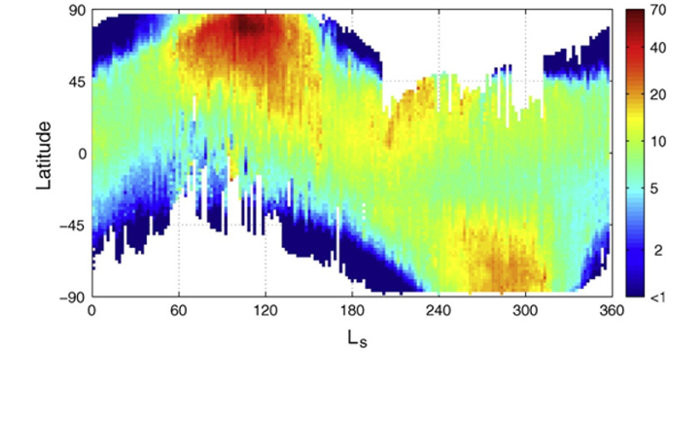
While numerous studies have been performed to monitor water vapour and surface frost in the Martian atmosphere, some specific work is required to use them in a synergistic manner and in particular to make them usable to constrain climate models. For this purpose three specific studies will be performed:
- The various water vapour measurements available from Mars Global Surveyor and Mars Express will be gathered, compared and combined. Previous comparison of water vapour abundance results obtained from TES and the PFS, SPICAM and OMEGA instruments on Mars Express showed general agreement, but enough systematic differences to make precise comparison difficult. Within this project, we will conduct research on a selection of these enigmatic discrepancies (which could be, for instance, explained by an unexpected vertical distribution of water vapour) using the new synergistic algorithms that are able to combine spectral data from various instruments.
- Similarly, additional information on the vertical distribution of water vapour will be obtained using new Mars Express limb observations.
- In parallel, a climatology of seasonal surface frost as observed by the Mars Express OMEGA imaging spectrometer will be prepared in direct collaboration with the OMEGA team in order to allow an “apple to apple” comparison with the Global Climate Model.
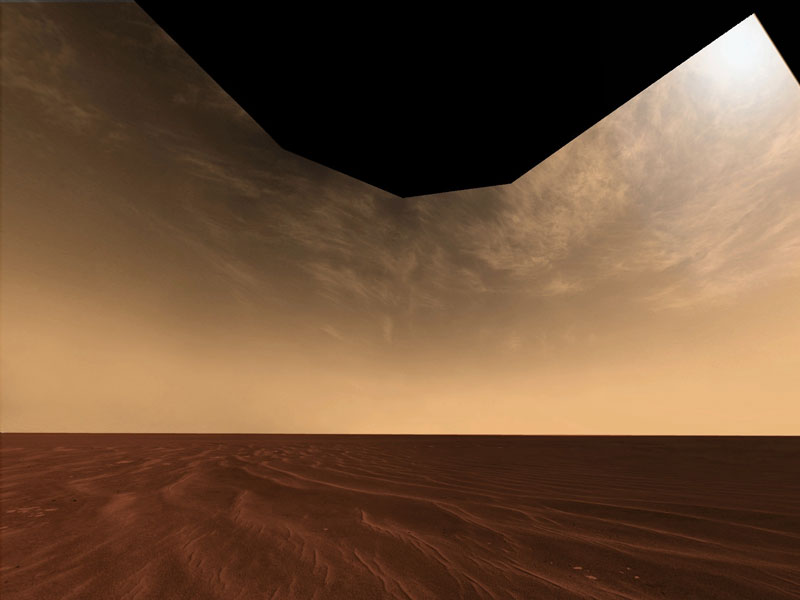
Credit: Mars Exploration Rover Mission, Cornell, JPL, NASA Image processing: M. Howard, T. Öner, D, Bouic & M. Di Lorenzo for unmannedspaceflight.com.
Using the information obtained from the previous studies, a new generation model of the water cycle (including an improved representation of clouds, frost and exchange with the sub-surface) will be included in the LMD Global Climate Model and validated by the observations. The LMD Mars Global Climate Model includes a Mars water cycle which now account for the radiative effect of water ice clouds, a detailed cloud microphysics and for which a new parameterisation of exchange with the subsurface has been recently developed. It will be carefully validated and tuned using all observations from UPWARDS. In light of these comparisons and using the observations, new or improved parameterisations will be included in the model in order to better account for sub grid-scale cloudiness, the thermodynamics of surface frost, the sensitivity of cloud particles nucleation to temperature, and possibly all new physical processes that may be revealed by our studies.
Dedicated Work Package: WP4
Links to other UPWARDS activities: WP1, WP2, WP3, WP4, WP7, WP8, WP9
Related Papers:
Haberle et al., Paper presented at the 4th International Workshop on the Mars Atmosphere: Modelling and Observations, Paris, France(2011)
Navarro et al., Paper presented at the 5th International Workshop on the Mars Atmosphere: Modelling and Observations, Oxford, UK (2014)
Fouchet et al., Icarus, Vol. 190, pp. 32-49 (2007)
Maltagliati et al., Icarus,Vol. 213, pp. 480-495 (2011a) 49Madeleine et al., J.Geophys. Res., Vol. 117,E00J07 (2012a) 50Mateshvili et al., Planet. Space Sci., Vol. 57, pp. 1022-1031 (2009)
Smith, M.D., Icarus, Vol. 167, pp. 148-165 (2004)
Maltagliati et al., Science, Vol. 333, pp. 1868 (2011b)
Tschimmel et al., Icarus, Vol. 195, pp. 557-575 (2008)
Fouchet et al., Icarus, Vol. 190, pp. 32-49 (2007)
Korablev et al., paper presented at the 2nd International Workshop on the Mars Atmosphere Modelling and Observations, Granada, Spain (2006)
Tschimmel et al., Icarus, Vol. 195, pp. 557-575 (2008)
Maltagliati et al., Science, Vol. 333, pp. 1868-(2011b)
Langevin et al., J.Geophys. Res., Vol. 112, E08S12 (2007)
Vincendon, M.,Forget, F.and Mustard, J.,J. Geophys. Res., Vol. 115, E10001 (2010) 60Appéré et al., J.Geophys. Res., Vol. 116, E05001 (2011)
Montmessin et al., J.Geophys. Res., Vol. 109, E10004 (2004) 62Madeleine et al., J.Geophys. Res.Lett.,Vol. 39, pp. 23202 (2012b)
Navarro et al., paper presented at the 5th International Workshop on the Mars Atmosphere: Modelling and Observations, Oxford, UK (2014)







